Yes, writing is hard, and the biggest challenge of email marketing is coming up with persuasive words to reach your target audience to take an action.
That’s why mastering the art of email copywriting should be a top priority for all marketers, and why we put together this handbook to help you.
With effective email copywriting, you can put together more creative and consistent campaigns while also scoring more sales and clicks.
Luckily, you don’t have to be a creative genius or marketing wizard to write great email copy. You just need to understand the principles of persuasion and what makes for a great email.
Soon you’ll be well on your way to writing email copy that converts your prospects, no matter what you’re selling!

What is Email Copywriting?
Your main task as a copywriter is to promote a product, service and idea. You want to persuade people to buy, join or sign up. The trick is finding the right words and style to make this happen.
Email copywriting is not a recent creation … it goes all the way back to when writing was invented. But nobody was born with excellent writing skills. You develop these over time. It begins with a mind open to ideas, the willingness to learn, and copying from the best.
Copywriting is centered around persuasion and sales versus just writing about information. Copywriters focus on generating excitement, anticipation, and empathy from readers rather than educating them.
As a result, you need to get your point across quickly. Space in an email is limited, and your readers’ attention span is so small as to be microscopic… and there’s probably dozens of other emails vying for their attention!
Email copywriting means choosing your words carefully.
To become a great email copywriter, start with small steps. Adopt a daily routine of simple tasks. Try the following to enhance your creativity:
- Look at 10 ads from different fields/industries. Re-write each of them.
- Keep reading books! When reading magazines, study the ads.
- Take a break away from all distractions. Write anything. You might find inspiration.
- Solve any puzzle (crossword, Sudoku, etc.). The mental exercise will do wonders to your brain.
- Take a walk and form interesting sentences in your head. A lot of my best copyrighting headlines come while exercising. That’s how I came up with “turn meh into magnificent!”
- Talk to people. Ask about their needs and wants. There’s always something to learn.
We engage with email copywriting hundreds of times daily. Billboards, social media ads, television and radio commercials, the list goes on.
The Elements of Email Copywriting
There are several elements to keep in mind while writing your emails. Keep these in mind to become a superstar writer to convert your readers into buyers!
Empathize With Your Audience
First of all, put yourself in the shoes of your target audience. It’s no longer enough to determine their age group, income, gender, income bracket and location of your target market. Add to this mix the following:
- wants
- needs
- hobbies
- interests
- lifestyle
- values
Baby boomers have different priorities and worries than Millennials. Gen-Z is more tech-savvy than other groups. Older people are more concerned about their health and retirement. Younger people are more worried about finding a job and housing. Whoever your target is, try to view the world from their eyes.
For example, what keeps your readers up at night? What are their biggest pain points and desires? What should they want to hear from you?
The challenge of email marketing, of course, is that even with segmentation and personalization, you’re still sending out emails en masse to a wide group of people. The key is to make your messages feel like they’re tailor-made for your readers, speaking directly to them.
To help, use “you,” “yours,” or your customers’ names in messages. Mention pain points and desires (think: fears and goals) and talk about your product as the solution.
Always be positive. Imagine that they are your best friend, and they are coming to you for advice. What would you say? You’d likely talk about how it helps them, which leads to our next point.
Prioritize Benefits and Emotions Over Features
Instead of talking about your product, talk about how it will benefit them. How would they feel as a homeowner rather than just a renter? How does it help them?
If you’re selling insurance, don’t talk about what it’s about. Instead, talk about how secure they’ll feel knowing that they have a secure future for their loved ones. Talk about benefits and feelings before features.
We see this all the time with tech and software companies. The next time you see an ad (or an email) trying to sell you an Internet service, effective email copywriting doesn’t first talk about speeds or technical details. No, they talk about how you can stop stressing about slow speeds, and how you can watch your favorite movies without lagging.
Think about a happy, comfortable family watching a movie. That’s how you sell Internet services.
In short, you need to focus on feelings and outcomes associated with your products. Let’s look at an example:

The email from Casper is a solid example of finding the balance between benefits and features. They first talk about “Your dream bed,” and comfort and rest (the benefits for the reader), not what type of mattresses they sell. The features come later, after the reader is hooked and reading. The message puts feelings and benefits before anything else.
People are wired to respond to feelings and emotions first. When you craft your emails, always have this top of your mind. How would your customer FEEL owning this product? It goes back to knowing and understanding your audience.
Write Like You’re Having a Conversation
Email inboxes are flooded with emails. A lot of them will be low-effort and spammy.
You don’t want to be part of this. This means talking to your audience as a friend rather than a marketer. Here are some basic, straightforward writing tips to help you get your message across in a natural, personable way:
Use shorter sentences: Most people don’t speak in paragraphs. Use short, direct, emotional sentences. Shorter sentences also helps with readability, as most people will be reading your emails from a mobile phone.
Simplify your language. No jargon, no big words. Only use jargon if you are sure your audience speaks it (ie it shows that you are “one of them.”) Your writing should be about at the 8th grade level. You can use a readability checker like the Hemingway Editor to see how complex your writing is.
The Art of Persuasion
So more you are empathizing with your audience and know (or have an educated guess) as to their dreams and worries. You know to talk about the benefits of what you are selling, and you write like you are talking to a friend, with short sentences and simple words.
Now, how do you actually persuade your reader to click the link to buy your product?
Urgency and Scarcity
The #1 method is having a sense of urgency and/or scarcity. Check out this email:

You likely get emails like this everyday. LAST CALL! TIME IS RUNNING OUT! SUPPLIES ARE RUNNING OUT! This is also known as FOMO, or “fear of missing out”, and it’s probably the most powerful persuasive tool to get your reader purchasing.
Ask your affiliate manager if there are special deals happening that your audience will be interested in, so this isn’t just a fake urgency, but an actual deal. However, you can certainly be creative and word your email in such a way that it’s a limited time deal and to ACT NOW!
What They Get In Return
Similar to making sure to list the benefits of the product to your reader, think about your relationship with your subscriber.

This welcome message above has a free offer. People love claiming offers, not just because it’s free, but because they also feel appreciative that you are doing something for them.
This may be more important for ecommerce businesses, but you can do a twist with CPA emails. Think about the popularity of free gifts and resources in email marketing. Ask your affiliate manager about offers with coupons and freebies. This encourages readers to take action because you’re giving them an extra benefit just for them, and they will often feel the need to respond.
Social Proof
How good is the product you are offering? Well, here are real reviews from buyers, and how it helped solve their problem.

This ad above is geared towards pet owners and the social proof of happy pets, but the same can be done for CPA offers. How many satisfied customers are there for your offer? How did it make their life better? You’ll often see customer testimonials and reviews on the company’s website, which you can use in your emails to show how this offer helped people like YOU.
The AIDA Principle in Email Copywriting
The AIDA principle is just as important today as it was a hundred years ago. It has stood the test of time and has become a benchmark for advertisers, online and offline marketers, and copywriters, ever since its inception.
 AIDA is an acronym and stands for:
AIDA is an acronym and stands for:
Attract
Interest
Desire and
Action.
A copywriter named Elias St. Elmo Lewis formulated the slogan way back in 1899:
“Attract attention, maintain Interest, create Desire and get Action.”
This principle can be successfully applied to all forms of advertising including sales letters, web page content, PPC and Social Media ads, product descriptions and, of course, email marketing.
AIDA is a tried and thoroughly tested strategy that works. It should be applied wherever possible.
Now, let’s look at the AIDA formula in more detail and see how it might be applied to emails, ads, titles and product descriptions.
A = Attract.
This refers to attracting the attention of the prospect, whether that’s a customer, client, a buyer, a shopper, a lead or whatever label you want to use that best describes the person whose attention you want to attract.
The best way to attract a person’s attention is with a headline, a subject line or a product title. This is the first line of text that the prospect will see and hopefully read. Its prime objective is to get noticed. Very often it will consist of a statement or ask a question. A question needs an answer and so this is how it can lead the prospect to read the rest of the copy.
With a sales letter and an email subject line however, there is plenty of scope for a killer headline, but with product descriptions there are some character limitations. It is therefore always a good idea to focus on including a main keyword. We’ll look at keywords in more detail later.
So, the headline has to stop the reader in their tracks and make them want to read the rest of the ad, which is the body copy or description, and that’s where the next part of the formula takes over.
I = Interest.
This is this part of the copy that has to work hard at keeping the reader interested by expanding on the promise or statement that was made in the subject line. Getting your prospect interested in your offer or your product is key to drawing them in by educating them about the benefits of the offer.
Every salesperson should know that it is the “benefits” that sell products and services above all else. A benefit is what the prospect will receive from buying and using the product. It is the end result. That is what the prospect is really buying and it’s the burning question they all have, without exception, before making a buying decision.
D = Desire.
Now we’re really getting into the emotions of the prospect and this is the most powerful tool any sales person will have at their disposal.
Virtually every buying decision is an emotional one. The best way to get the emotions going is by getting your prospect to visualize the benefits.
For example, what are the benefits of driving that brand new car? They need to be able to see themselves driving it up their street and parking it on their driveway.
Smell the new leather seats and the fresh interior. Imagine holding the smooth steering wheel and feeling the acceleration of its powerful 241 hp engine. Experience the thrill of driving on the freeway in cruise control. Lay it on thick and get them drooling over this car.
What we are doing is creating visions and feelings. We are stirring the emotions of the prospect. We are creating a desire to want to own this car and act out their dreams, their fantasies. Copywriters call this, creating “wanton lust”. It works and is responsible for selling billions of dollars’ worth of products all around the world.
When it’s time for action…
A = Action.
There comes a point when, towards the end of the email, you will want your prospect to take positive action towards making a purchase. Most often this will be a case of just writing something like “Buy Now” or “click below”.
It’s important that you do tell the prospect what they have to do next. It’s simply a matter of leading them to the final part of the sales process. If the title and description have done their part then this should be a straight-forward procedure. However, you can increase your chance of making the sale by adding a few choice words.
This is where certain “trigger words” come into play. To help your prospect make a buying decision you can add a short sentence like, “Last few remaining” or “While stocks last” or “Limited offer”.
The scarcity factor can help the prospect decide quickly because there is a suggestion that they could miss out if they don’t. It’s always a good idea to make each product description sound like it’s a special offer, which will prompt the prospect to take action when they get to the end of reading the description.
Writing your newsletter
Now we’ll jump into actually crafting good email newsletters. Each section and part of your email is important and should give value alone just as they do as a whole.
The Subject Line
First, let’s start with the subject line. Email service providers usually limit you to 45 characters or less, so your customers must be able to get a good idea of what the email is about just by reading this part of the email.
Shorter subject lines are less likely to be cut off in mobile and are easier to read and understand at a glance.
Here’s a couple more tips:
- Don’t rely on a single style or format of subject lines. Variety will keep your messages from growing stale or feeling too copy-and-pasted.
- Incorporate power words and attention-grabbing copy in your subject lines, including names, numbers, and questions (we’ll get into these “power words”).
Keep in mind that most people will only read your subject line before deciding whether they want to open it or not!
Here are some proven hacks for writing a captivating subject line:
Ensure that the most important words are near the beginning of your subject line – This way, people can quickly identify what the email is about even before they open it. For an educational guide, for example, I would write something along these lines:
- “Get your emails read with this guide!”
- “Write better emails here”
Use numbers in your email titles – Using numerical data on your subject line makes it more noticeable in a sea of emails. You can use statistical data, the page-length of a free downloadable, a discount, etc.
- “Just 52 Spots Left”
- “Our #1 Most-Asked Question”
- “100 Days and Counting…”
Use actionable verbs – In email marketing, your subject line is your first call-to-action. Your main goal is to get them to click, so writing your subject lines in a way that compels them to click is your first step. For example:
- “Click to Boost Your Email Open Rate By 20%”
- “Download this guide to learn about emails”
Use questions – Questions naturally pique readers’ interest as a sort of call-and-response, inclining them to click through to learn the answer.
- “Have gifts to send?”
- “Question for your doc?”
- “How much do you know about sleep?”
“You” subject lines – These headlines work well by addressing your readers directly, by saying “you” or using the actual name with personalization tags.
- “Expiring soon, Jane: Your 10% Discount”
- “Here are the Earpods you were looking for”
- “You need a beach day.”
Conversational – These types of subject lines feel like they were written for a friend or family.
- “Yo, before we completely finish the year…”
- “Hey New Bae on the Block 🖤”
Use emojis (not too often) – Most email platforms support displaying emojis on subject lines, which you should definitely use to stand out!
These colorful icons will help your email pop out and are easier to notice in a full inbox … but only one or two per subject line, and don’t use them in every email you send.
So, how do you know which subject lines are performing best for your readers?
View and analyze the data!
Your email software will be able to show you which subject lines are performing best for your audience, so take some time to study what’s working and leverage that information.
The two important metrics you’ll need to review to check effectivity of your subject lines are:
- Email Clickthrough Rate – This tells you how many people clicked on a specific email out of everyone who received it.
- Email Delivery Rate – Email service providers usually allow up to a certain number of emails per hour (e.g., 100), so if they go over this limit, customers won’t receive them all at once
The Email Description
The email description is the short preview that is shown next to the subject line. In Gmail, it appears like this:

This should give context and allow your reader to know what to expect inside your email.
As the subject line grabs their attention, the description should then further pique their interest and lead them to opening the email.
In mobile, usually only the first 35 characters of the description will be shown, and underneath the subject.
The Email Body
What does your brain automatically think of when you see a wall of long text? Remember those textbooks in high school or college? How much fun were they to read?
Email newsletters can be a lot like those boring textbooks. To make your audience happy and keep them reading your email newsletters, pay attention to design.
Here are some tips for creating a better reader experience:
- Use visual sections. Organize your email content into sections for more effortless reading by adding titles above each paragraph in bold font, which stands out from everything else on the page.
- Add headings and subheadings in bold. This helps divide different points within each section allowing people who want more details about specific issues to go straight to the corresponding subheading below, where they’ll find even further detail about what interests them specifically.
- Use italics. Highlight and emphasize important parts of the newsletter.
- Use bullet points. Emails are a lot easier to read when you use bullet points rather than paragraphs.
- Add whitespace. Emails are easier to read when they have a lot of whitespace between each section, heading, and paragraph.
- Keep it simple! Emails that use dark backgrounds or too many colors can make it difficult for your audience to digest all the information you’re trying to convey. Stick with simple design elements like white space and headings in bold font, so your email newsletter looks clean and easy to read.
- Use images if they add to the experience. Images can make reading through your content much more fun because your readers’ eyes are naturally drawn towards visuals. They also make your email newsletter look more engaging and appealing. Use images that are relevant to the topic you’re currently writing about.
- Optimize for mobile. Make sure your email is displayed in the right dimensions for any screen! All modern email platforms use page responsiveness so emails are formatted for desktops and mobile. Most emails are read on mobile.
As for the length, when in doubt, adopt a “less is more” mentality. Consider that the optimal length for a business message sits somewhere between 50 and 150 words.
Although there are plenty of longer-term storytelling emails out there, conventional wisdom says that you should keep your copy as brief as possible. You don’t want to require your readers to slog through paragraphs if they don’t have to, particularly on mobile.
This is where simple language and short sentences can really save the day.
Call to Action
The last piece of any marketing email is your call-to-action. This is the moment where people take action. And you MUST guide them.
Saying “Click Here” isn’t necessarily going to tank your click-through rate, but it doesn’t do much to get the average recipient excited. “Shop Now” might seem more actionable, but this CTA also feels generic and almost treats your customers as a transaction first and a person second.
Coming up with a CTA isn’t difficult, but it should tick the following boxes:
- Highlight a specific action (“Complete your order”).
- Remain on the shorter side (two to four words, short enough to reasonably fit in a CTA button).
- Be relevant to the offer. You wouldn’t use “Learn More” when selling a product to buy, but it would work if you’re exploring the benefits of a health insurance offer.
Email Structure
Most marketing emails these days stick to a familiar and proven format that looks something like this:
- Headline
- Image
- CTA
- Subheader
- Sentence
- Image
- Subheader
- Sentence
- Image
- CTA
Using brief sentences, questions, and statements makes it easier for people to flow through your messages without getting overwhelmed.
This email below follows a similar format: Headline → CTA → Image → Subheader → Sentence → CTA, which cleanly organizes the email and enables your recipient to focus on each piece of it.
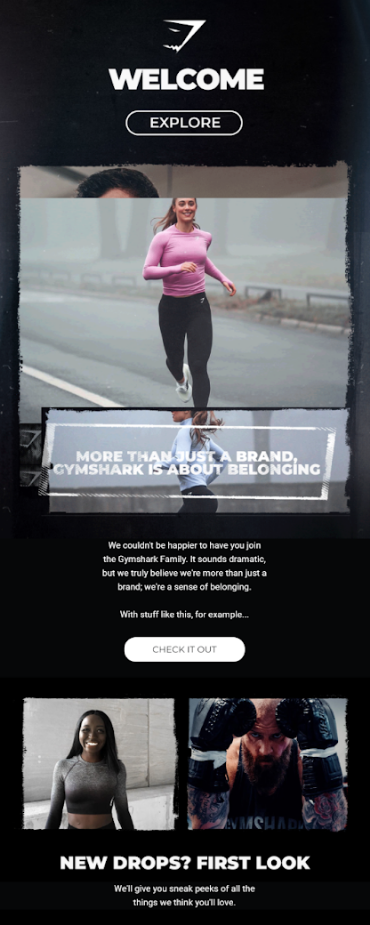
Email Copywriting Tips
Read Out Loud
If anything sounds awkward or unnatural, scrap it.
Use Power Words
If you’re struggling with finding the right words in an email, start with terms that are proven to put readers at ease.
Below are some terms that marketers rely on all the time in emails and ads. Each of these phrases (and their synonyms) represents “power words” (or “action words”) that are perfect for sprinkling throughout your subject lines, headlines, and body content alike.
Simple
Ease of use and helpfulness, this power word reassures that what you’re offering won’t require much effort.
- “The simple way to program your 🧠 to win”
- “Build your website in a few simple steps”
Quick
Quick implies a painless, seamless experience and fast results that your customer can enjoy ASAP.
- “A quick heads up…”
- “Close deals faster with these quick tips”
Limited
Recalling that sense of urgency and scarcity, this term is sure to tap into your customers’ “Fear of Missing Out”.
- “Our Most Limited Release of the year”
- “Revive your walls! Limited edition art from $25”
Proven/Tested
This term gives your readers peace of mind, reassuring them that you’re legit and have been around the block.
- “Our best plan – Tested”
- “Email openers – Trusted and Proven 🏆”
Invitation
This term presents your message as something positive and tailored exclusively for your subscribers.
- “Your exclusive invitation to preorder”
- “Sally, you’ve been invited”
Of course, these aren’t the only power words out there. Terms such as soon, easy, fresh, and thanks are similarly fair game and can easily be coupled with the phrases above. You don’t need to exclusively use these terms, but they definitely come in handy when you need inspiration or are brainstorming headlines.
Just as there are positive power words, keep in mind that there are spammy terms that you should avoid. Phrases like free, deal, cheap, or pre-approved can send the wrong message and likewise land you in the spam folder.
Use Templates
No need to start your marketing emails from scratch. As you now know, most marketing emails follow similar templates and formulas. Once you’ve sent a variety of emails and have a better sense of what sort of length, formatting, and styles make sense, you can save your top-performing templates and simply change the wording accordingly.
Check Your Email Stats
Open-rates. Click-through-rates. Conversions.
Tracking your engagement metrics will let you know how effective any given email marketing campaign is and where you can improve. You might learn that longer-form messages perform better, or a specific CTA has a higher conversion rate.
Lean on Your Subject Lines and Headers
Almost nobody reads your messages word-for-word. Pique their interest with an interesting subject line, then use bolded headers, and calls-to-action to naturally catch your readers’ eyes. You must make your messages easy to scan.
Add Your Personality
Remember to inject your personality in your content too. Emails are a dime a dozen, and you’re battling hundreds of other emails hitting your reader’s inbox daily, all vying for their attention.
So what’s going to make your email stand out from everything else, and what’s going to make your reader want to continue coming back every time you send a new email to them?
Nobody wants to read a dull, lifeless sales pitch that doesn’t offer anything of value.
So while you’re writing your emails, don’t be afraid to inject some of yourself into it – make it relatable, add in some humor if appropriate, or give examples from real-life situations.
This will help engage your reader emotionally, which they’ll remember more than facts and statistics.
Keep Practicing
Practice won’t make perfect, but it definitely helps! Getting better at writing marketing emails is no different than improving in any other creative field. The more emails you write, the easier the process becomes. Sticking to the email copywriting tips above, using templates, and refining your messages based on data will ensure that you improve faster.
4 Email Copywriting Examples (and Why They Work)
Improving as a copywriter means drawing inspiration from proven brands and marketing messages. Before the Internet, copywriters would keep physical copies of ads in a “swipe file” to reference whenever they needed ideas for a new campaign. Use these as your swipe file starter pack:
Willo
This email combines both urgency (“The countdown has started…”) and scarcity (“making 1,000 units available”); this message drives readers to take action while being brief about it. Headers in a different color and widely spaced help readers zero in on the message’s key points, too.
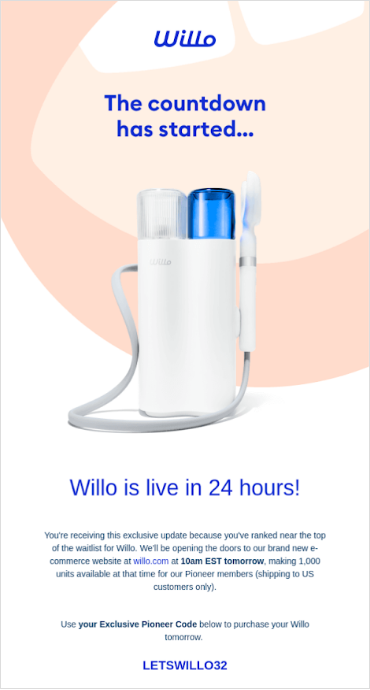
Nuggs
This email message feels like a human wrote it with conversational copy and a sense of humor. The short message makes everything more impactful. This is definitely a “Less is more” email.
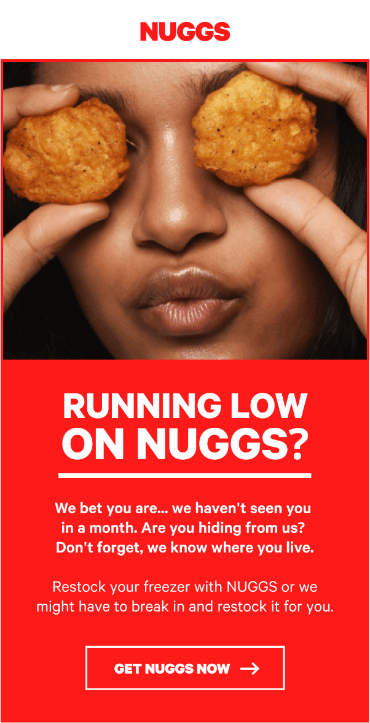
Uber
Uber keeps their emails simple and concise. The headline clearly states the benefit, and then lists another benefit of booking in advance below (pickup with 60 minutes of wait time included).
They then have a clear CTA that is simple and easy to read.
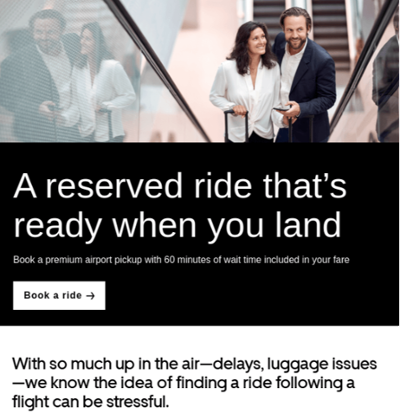
Mom and Dad Money
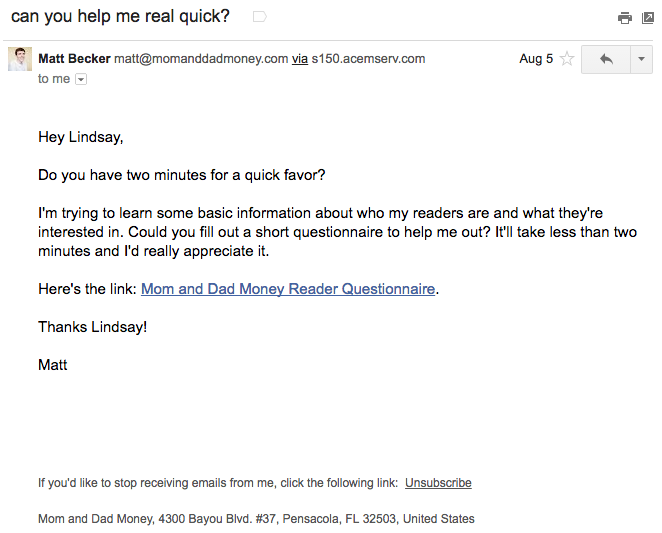
This marketer went the personal angle and treats you like a warm, casual friend, using power words in the subject line. This person asks a simple question in a short and sweet email, and says that it is simple and quick.


